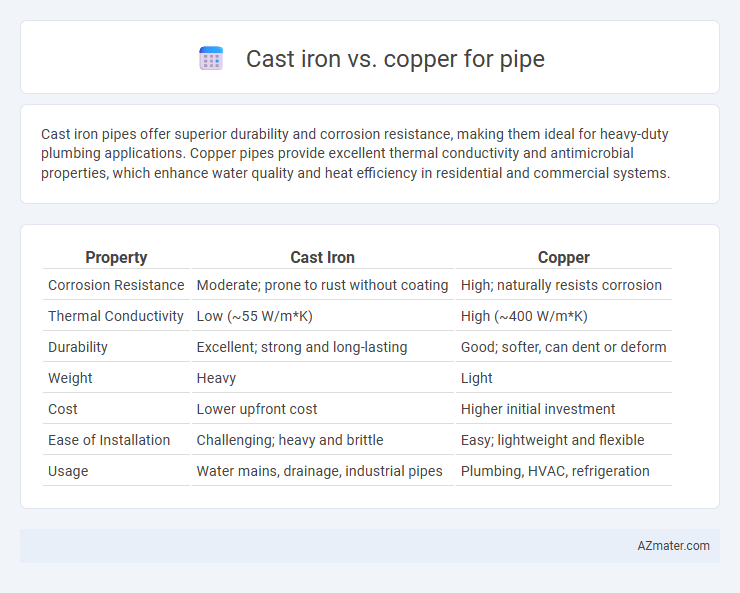Cast iron pipes offer superior durability and corrosion resistance, making them ideal for heavy-duty plumbing applications. Copper pipes provide excellent thermal conductivity and antimicrobial properties, which enhance water quality and heat efficiency in residential and commercial systems.
Table of Comparison
| Property | Cast Iron | Copper |
|---|---|---|
| Corrosion Resistance | Moderate; prone to rust without coating | High; naturally resists corrosion |
| Thermal Conductivity | Low (~55 W/m*K) | High (~400 W/m*K) |
| Durability | Excellent; strong and long-lasting | Good; softer, can dent or deform |
| Weight | Heavy | Light |
| Cost | Lower upfront cost | Higher initial investment |
| Ease of Installation | Challenging; heavy and brittle | Easy; lightweight and flexible |
| Usage | Water mains, drainage, industrial pipes | Plumbing, HVAC, refrigeration |
Introduction to Cast Iron and Copper Pipes
Cast iron pipes, known for their durability and excellent noise-dampening properties, are traditionally used in drainage and sewer systems due to their high resistance to corrosion and long lifespan. Copper pipes, favored in plumbing for water supply lines, offer superior corrosion resistance, antimicrobial properties, and ease of installation with reliable joint connections. Both materials provide distinct advantages depending on the application's requirements for strength, longevity, and water quality maintenance.
Historical Use of Cast Iron and Copper in Plumbing
Cast iron pipes have been historically prominent since the 19th century for their durability and resistance to pressure in municipal water systems. Copper gained popularity in the 20th century due to its corrosion resistance, ease of installation, and bacteriostatic properties reducing microbial growth in plumbing. Both materials shaped modern plumbing, with cast iron favored for drainage and copper widely used for potable water supply lines.
Composition and Material Properties
Cast iron pipes, composed primarily of iron with carbon content ranging from 2 to 4%, exhibit high compressive strength and excellent durability but are prone to corrosion over time. Copper pipes consist mainly of copper with small amounts of zinc and lead, offering superior corrosion resistance and flexibility, along with high thermal conductivity. The choice between cast iron and copper pipes depends on factors like mechanical strength requirements, environmental conditions, and cost considerations.
Durability and Longevity Comparison
Cast iron pipes exhibit exceptional durability due to their high resistance to abrasion and corrosion, often lasting up to 50-100 years in typical plumbing systems. Copper pipes offer strong longevity as well, commonly exceeding 50 years, with superior resistance to corrosion and biofouling in potable water applications. The choice between cast iron and copper depends on the specific environment and maintenance, as cast iron withstands heavy mechanical stress while copper excels in corrosion resistance and hygienic water delivery.
Corrosion Resistance and Maintenance Needs
Cast iron pipes exhibit high corrosion resistance due to their thick, protective oxide layer, making them well-suited for harsh environments with minimal maintenance requirements. Copper pipes naturally resist corrosion through a protective patina that forms over time, reducing the need for extensive upkeep but may require inspections in highly acidic or alkaline water conditions. Maintenance for cast iron involves occasional rust prevention treatments, whereas copper pipes demand monitoring for pinhole leaks caused by erosion or water chemistry changes.
Installation Process and Labor Considerations
Cast iron pipes require heavier tools and more labor-intensive techniques such as cutting with a saw and joining with lead or rubber gaskets, making installation slower and requiring skilled labor. Copper pipes are lighter and more flexible, allowing for quicker installation using soldering or push-fit fittings, reducing labor time and complexity. The choice significantly impacts overall project labor costs and scheduling due to these material-specific installation demands.
Cost Differences: Initial and Long-Term
Cast iron pipes typically have a lower initial cost compared to copper, making them a budget-friendly option for large-scale plumbing projects. Copper pipes, while more expensive upfront, offer greater durability and corrosion resistance, reducing maintenance and replacement expenses over time. Long-term cost efficiency often favors copper due to its longevity and minimal repair requirements despite its higher initial investment.
Environmental Impact and Sustainability
Cast iron pipes offer high durability and are highly recyclable, reducing landfill waste and conserving natural resources throughout their lifecycle. Copper pipes, while energy-intensive to produce, are also fully recyclable and benefit from a longer lifespan due to corrosion resistance, which decreases the frequency of replacements. Both materials contribute to sustainable plumbing systems, but cast iron's lower energy requirement in manufacturing and higher recyclability make it a more environmentally friendly choice overall.
Common Applications and Suitability
Cast iron pipes are commonly used in drainage, sewer systems, and industrial plumbing due to their excellent durability and noise reduction properties. Copper pipes are preferred for residential water supply lines and heating systems because of their corrosion resistance, thermal conductivity, and ease of installation. Suitability depends on factors such as pressure requirements, budget, and building codes; cast iron excels in heavy-duty applications, while copper suits environments needing clean water delivery and moderate pressure.
Choosing the Right Pipe Material for Your Project
Cast iron pipes offer superior durability and excellent noise reduction, making them ideal for drainage and sewer systems in residential and commercial projects. Copper pipes provide outstanding corrosion resistance, longevity, and are preferred for water supply lines due to their antimicrobial properties and ease of installation. Evaluating specific project requirements such as budget, environmental factors, and intended use ensures selecting the optimal pipe material for performance and cost-effectiveness.

Infographic: Cast iron vs Copper for Pipe
 azmater.com
azmater.com